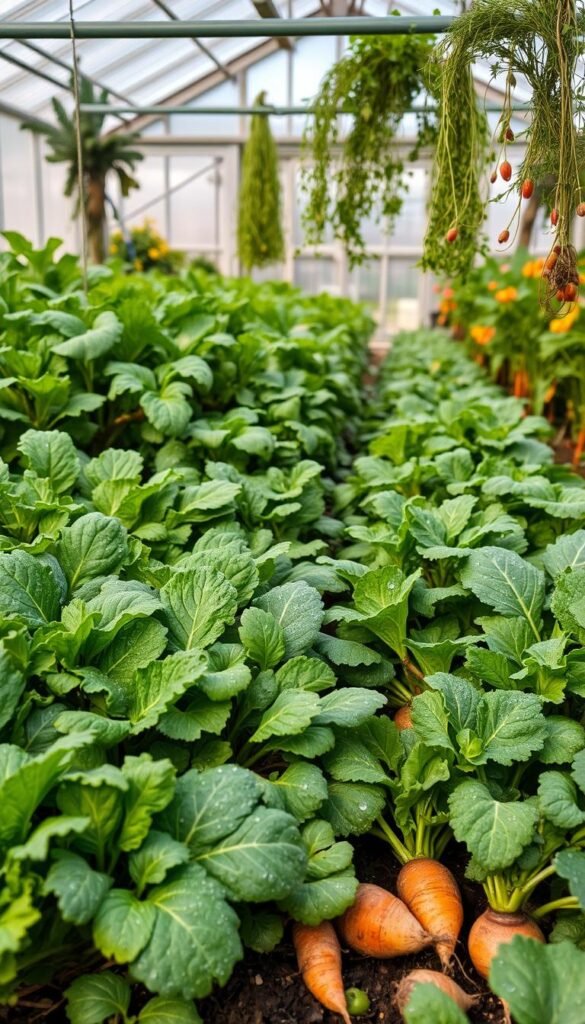Imagine stepping into a cozy, plant-filled space during the coldest months and still harvesting fresh veggies. With the right setup, you can grow nutrient-packed food even as frost settles outside. This method isn’t just for experts—it’s a practical way to enjoy homegrown flavors all year.
Choosing plants that handle cooler environments is key. Hardy options like carrots, kale, and spinach adapt well to lower light and mild cold. These varieties often produce sweeter yields after exposure to chilly air, making them ideal for extended seasons.
Timing matters too. Planting in late summer ensures crops mature before daylight dwindles. If natural light fades, affordable grow lights can fill the gap. Pair these tools with well-draining soil, and you’ll create a resilient system that outlasts frosty mornings.
Why settle for store-bought greens when you can snip fresh leaves inches from your kitchen? By focusing on sturdy plants and simple tech, you’ll reduce grocery trips and savor garden-to-table meals every month. Let’s explore how to turn your protected growing area into a cold-weather powerhouse.
Understanding Winter Greenhouse Gardening Essentials
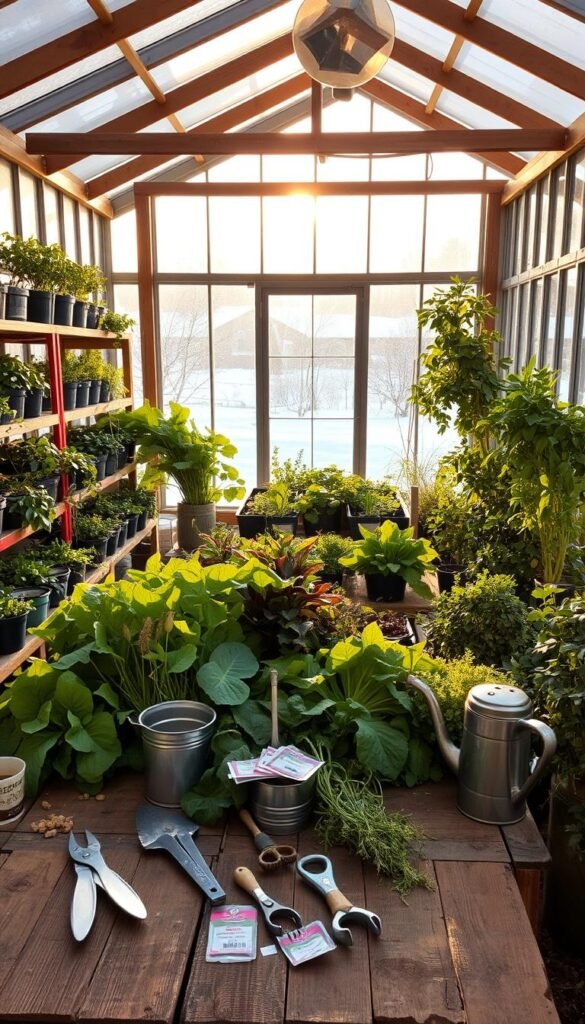
A well-planned protected space turns chilly days into harvest opportunities. By mastering a few core strategies, you’ll enjoy fresh greens and vibrant roots while frost lingers outside. Let’s break down what makes cold-weather growing work.
Benefits of Year-Round Gardening
Growing through colder months cuts grocery bills and boosts nutrition. You’ll skip wilted store-bought spinach—your leaves stay crisp until picked. Plus, tending plants year-round builds gardening skills faster than seasonal efforts.
Structured spaces also add value to your property. With smart seasonal care strategies, they become multipurpose hubs for seedlings, herbs, or even citrus trees.
Key Considerations for Cold Weather
Temperature stability matters most. Insulation kits or bubble wrap prevent heat loss at night. Pair these with a small heater set to 45°F (7°C) to protect tender shoots.
| Element | Purpose | Tips |
|---|---|---|
| Insulation | Retain warmth | Use thermal curtains on north walls |
| Heating | Prevent frost damage | Opt for energy-efficient models |
| Lighting | Boost growth | LEDs mimic sunlight for 6+ hours daily |
| Shelving | Maximize space | Install adjustable racks near windows |
Don’t forget light management. Reflective surfaces like white paint or aluminum foil direct scarce sunlight to your crops. Rotate pots weekly so all sides get equal exposure.
Choosing Cold-Hardy Crops for Your Greenhouse

Cold frames and unheated spaces can still yield crisp produce if you pick resilient varieties. Focus on plants that shrug off frost while delivering steady harvests. These champions adapt to fluctuating conditions, turning sparse sunlight into edible rewards.
Leafy Greens, Root Vegetables, and More
Kale and spinach lead the pack with their ability to regenerate leaves even after light freezes. For underground treasures, try radishes or turnips—their root systems store energy efficiently during short days. Onions also perform well, forming bulbs slowly but steadily in cool weather.
Don’t overlook Asian greens like tatsoi. They bolt less often than lettuce in unstable temperatures. Pair these with arugula for peppery salads that thrive without extra heat.
Tips for Selecting Varieties That Thrive
Seed packets are your cheat sheet. Look for phrases like “frost-tolerant” or “overwintering” on labels. Days-to-harvest should align with your growing season—opt for sub-60-day options if daylight dwindles early.
- Space plants 10-12 inches apart for airflow
- Mix compost into soil to prevent waterlogging
- Rotate beds yearly to avoid nutrient depletion
This cold-hardy plants list helps match varieties to your local climate. With smart choices, you’ll enjoy fresh leaves and crunchy roots regardless of the weather outside.
Winter Greenhouse Gardening: Best Crops for Chilly Temperatures
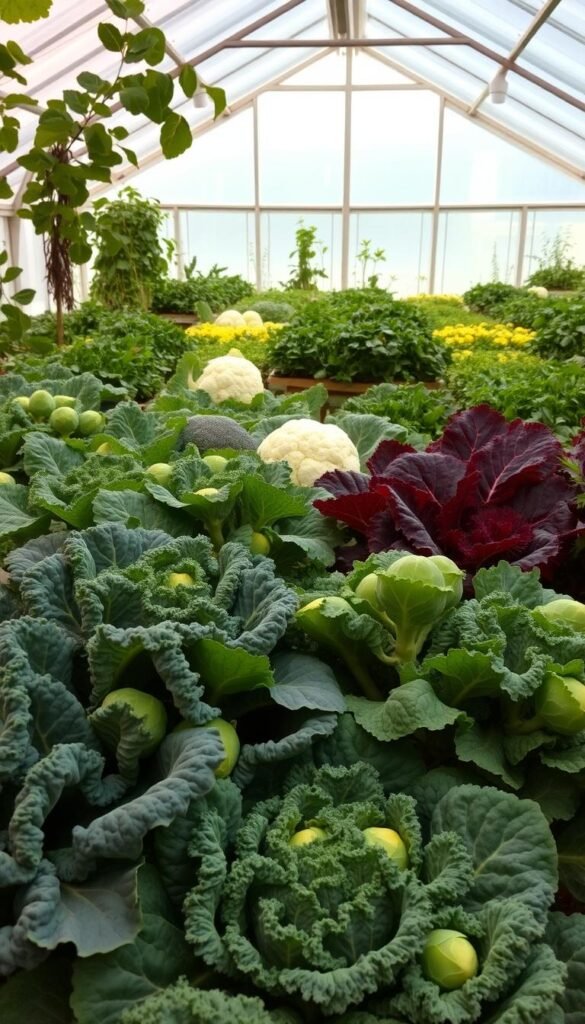
Extending your growing season doesn’t require complex setups—just smart crop choices. Plants that flourish in cooler conditions reward you with steady harvests, even as daylight hours shrink. Focus on varieties that prioritize resilience over speed, adapting their growth patterns to thrive in protected spaces.
Top Performing Crops in Low Temperatures
Carrots like ‘Napoli’ and ‘Mokum’ sweeten as temperatures drop, maturing in under 60 days when planted in early fall. Shakespeare onions, known for their cold tolerance, develop firm bulbs by mid-winter. Pair these with Lutz beets—their extended growth cycle allows harvests well into colder months.
Leafy greens such as mâche and claytonia handle frosty nights effortlessly. These cold-hardy vegetables grow slower but stay tender, perfect for repeated picking. For herbs, try winter thyme or curly parsley—both thrive with minimal light.
Managing Crop Maturity and Harvest Timing
Stagger planting dates every two weeks to avoid overwhelming harvests. Early fall-sown carrots might take 75 days instead of 50, so track progress weekly. Start clipping outer lettuce leaves once they reach 4 inches, letting inner leaves expand.
Root crops like beets signal readiness when shoulders peek above soil. For continuous yields, sow quick-growing radishes between slower varieties. This balances your workload and keeps your table stocked all season.
Integrating Grow Lights and Heating Solutions

When daylight dwindles, your plants still crave brightness and warmth. Supplemental systems bridge the gap, turning dim days into productive growing periods. The right combo keeps leaves vibrant and roots active, even when frost nips at your structure.
Choosing the Right Grow Lights
Not all lights work equally for every plant. Leafy herbs like basil thrive under blue-rich LEDs, while kale prefers full-spectrum bulbs that mimic summer sun. Match your setup to crop needs for faster growth in compact beds.
| Type | Best For | Benefits |
|---|---|---|
| LED | Herbs, kale | Low energy use, adjustable spectrum |
| HID | Dense beds | High output for large areas |
| Fluorescent | Seed starters | Budget-friendly, minimal heat |
Position fixtures 12-18 inches above plants. Timers ensure 12-14 hours of daily exposure—critical for herbs like parsley that bolt without consistent light.
Effective Heating Options and Energy Considerations
Protection from freezing temps starts with insulation. Line beds with thermal fabric or add foam boards beneath soil. Small electric heaters work well for zones with tender herbs, while propane units suit larger spaces.
Pair heating with thermal mass like water barrels. They store daytime warmth, releasing it overnight. This cuts energy costs while keeping kale and spinach safe during cold snaps. Always monitor humidity to prevent mold in tightly packed beds.
Soil Preparation and Fertility Management in Winter
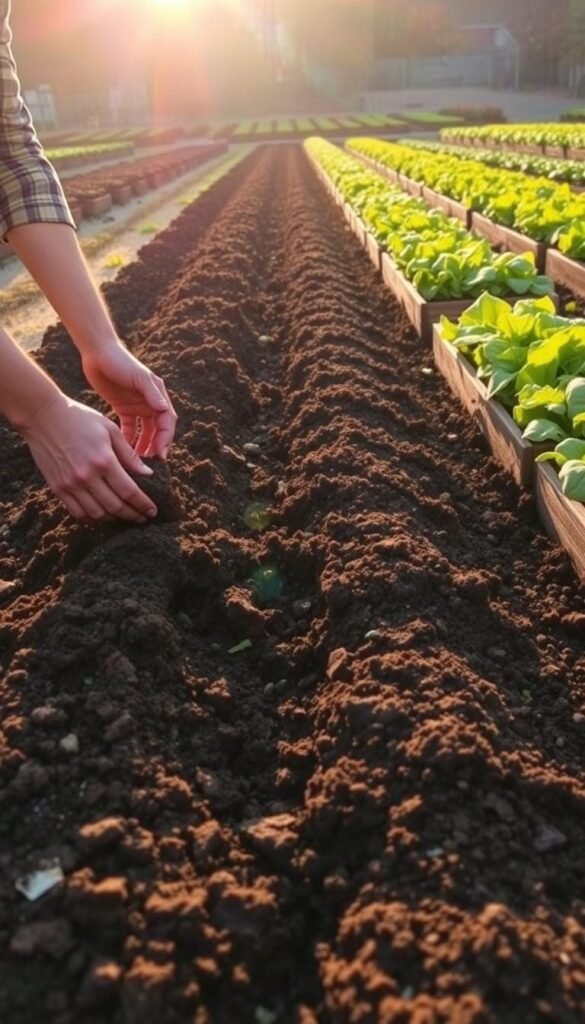
Healthy soil is the silent hero of every successful cold-season harvest. While frost nips at your structure, roots depend on nutrient-rich earth to fuel growth. Start by testing your soil’s pH—most greens and root crops thrive between 6.0 and 7.0.
Balancing Nitrogen, Phosphorus, and Compost Needs
Too much nitrogen pushes plants to grow leaves at the expense of roots—a disaster for carrots or beets. Mix compost at a 3:1 ratio with aged manure for steady nutrition. For phosphorus, bone meal (4-12-0) strengthens root systems without overwhelming greens.
| Component | Purpose | Ideal Ratio |
|---|---|---|
| Compost | Organic matter | 60% |
| Manure | Nitrogen boost | 20% |
| Peat Moss | Moisture control | 20% |
Apply fertilizers 2-3 weeks before planting seeds. This gives nutrients time to integrate, preventing chemical burns on delicate sprouts.
Enhancing Soil Structure for Root Development
Fluffy, well-aerated earth lets roots expand freely. Work in perlite or vermiculite if soil feels dense. In raised beds, layer straw beneath soil to improve drainage—critical when watering less in cooler times.
Check moisture weekly. Winter soils dry slower than summer beds, so overwatering risks mold. Top-dress with worm castings every 6 weeks to maintain microbial activity year-round. Your kale and spinach will reward you with deeper color and crunch.
Utilizing Greenhouse Space Effectively
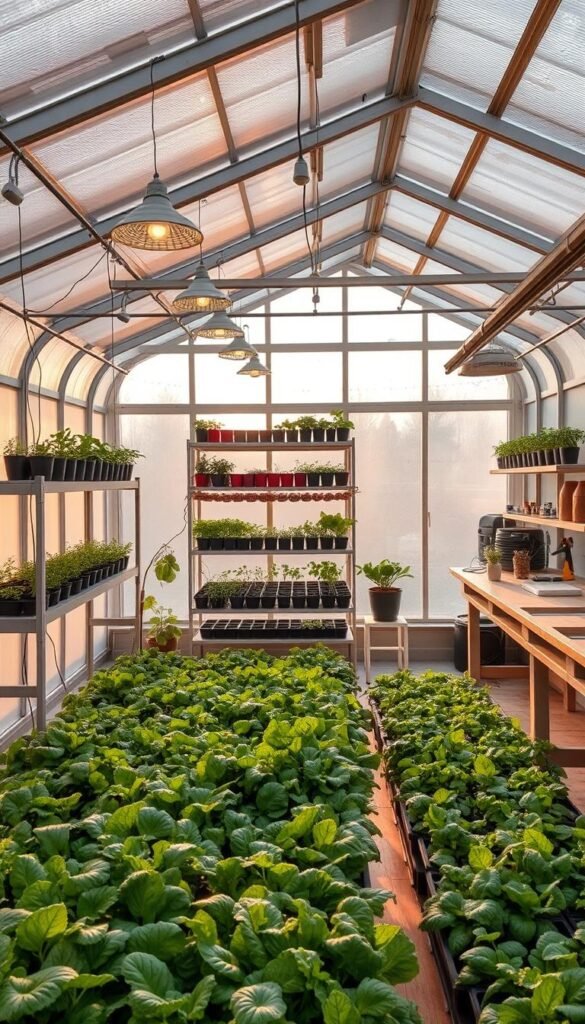
Maximizing every inch of your growing area transforms sparse setups into lush, productive hubs. Smart layouts let you grow more without overcrowding, balancing light access and airflow. Let’s explore how to turn vertical gaps and narrow corners into thriving zones for cold-weather harvests.
Vertical Gardening and Shelving Ideas
Wall-mounted shelves and hanging baskets unlock unused airspace. Install adjustable racks above planting beds for herbs like thyme—they’ll thrive while leaving soil space for beets or carrots. For trailing plants, try fabric pockets or repurposed gutters mounted near windows.
Stackable planters work wonders for leafy greens. Rotate them weekly so all sides catch light evenly. If shelves feel cramped, suspend pots from the ceiling with sturdy hooks. This keeps pathways clear and adds visual depth to your inside greenhouse.
Maximizing Planting Beds and Air Circulation
Arrange crops by height: place low-growing radishes at bed edges and taller kale toward the center. This prevents shading and lets air flow freely—a must in cold weather to avoid mold. Leave 8-10 inches between beets for roots to expand without competition.
Use perforated shelves or slatted tables to elevate containers. This improves drainage and lets warmth from heated floors reach plants. For tight corners, foldable planting boxes offer flexibility. Open them during sunny days to boost light exposure, then collapse when not needed.
Remember, a well-organized winter garden isn’t just about fitting more plants. It’s creating a system where every leaf gets sunlight and every root breathes easily. Start small, track what works, and watch your inside greenhouse become a model of efficiency.
Practical Winter Greenhouse Maintenance Tips

Regular upkeep keeps your growing space efficient and your plants thriving through frosty months. A little effort now prevents bigger headaches later, ensuring your cold-hardy varieties stay healthy and productive.
Cleaning, Inspection, and Repair Strategies
Start with a monthly deep-clean. Scrub surfaces with vinegar-water mix to remove algae and mold. Check seals around doors and vents—cracks let heat escape, disrupting your careful temperature balance.
| Task | Frequency | Tool |
|---|---|---|
| Glass inspection | Biweekly | Flashlight |
| Gutter clearing | Monthly | Gloves |
| Heater test | Weekly | Thermometer |
Replace broken panes immediately. Use temporary plastic sheeting if replacements arrive late. For drafty frames, apply weatherstripping tape—it’s cheap and cuts heat loss by 15%.
Pest Prevention and Disease Management
Cooler gardening conditions attract fewer pests, but aphids and spider mites linger. Hang yellow sticky traps near vents to catch invaders early. Wipe leaves with neem oil weekly to deter egg-laying.
- Remove fallen debris—it harbors fungal spores
- Space plants for airflow to reduce dampness
- Water soil, not leaves, to prevent mildew
Track temperature swings with a digital sensor. Sudden drops stress plants, making them disease-prone. Consistent conditions help winter crops like kale and carrots focus energy on growth, not survival.
Seasonal Planting Calendar for a Thriving Winter Garden
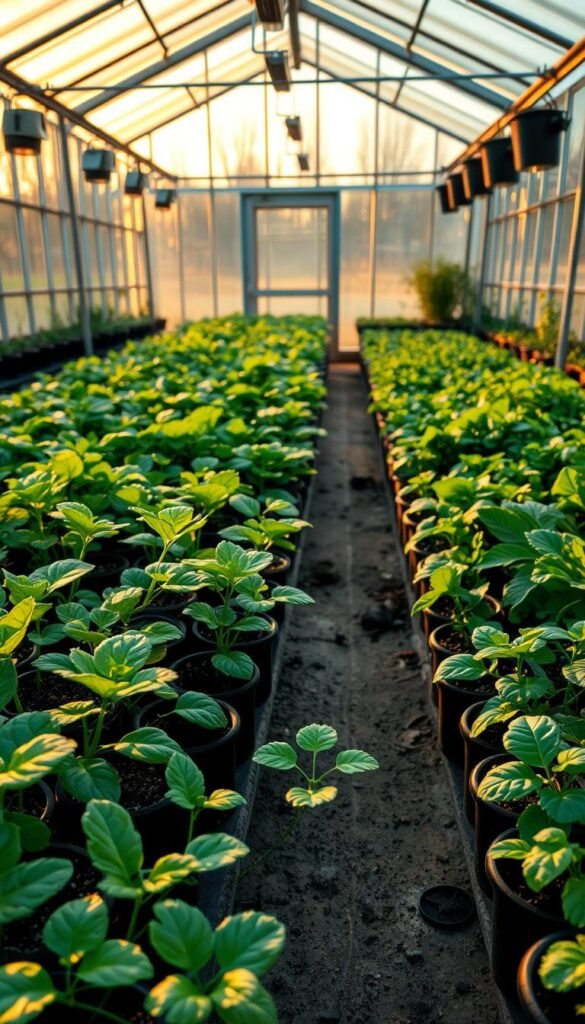
Timing your plantings like a conductor leads an orchestra creates harmony in your protected growing space. Sync seed starts with shifting daylight and temperature patterns to maintain steady yields. Let’s map out a strategy that bridges fall frosts and early spring thaws.
Fall to Spring Timeline Essentials
Start cold-hardy vegetables like spinach and peas in late August for October transplanting. Onions go in by mid-September—their long growth cycle needs 100+ days before spring bulb formation. Use this table to stay on track:
| Crop Type | Seed Start | Transplant | Harvest Window |
|---|---|---|---|
| Kale | Early Sept | Mid-Oct | Dec–Feb |
| Carrots | Late Aug | Direct sow | Nov–Jan |
| Spinach | Mid-Sept | Early Nov | Jan–Mar |
Track light levels monthly. When days dip below 10 hours, pause new sowings—focus on established plants. Resume in February as sunlight rebounds.
Interplanting for Non-Stop Yields
Grow quick types like radishes between slower carrots or beets. You’ll pull radishes in 30 days, freeing space just as neighboring roots need room. For leafy greens, stagger batches every 3 weeks. Clip outer leaves first to extend each plant’s productivity.
Pair crops with similar temperature needs but different heights. Low-growing arugula thrives under taller Swiss chard, maximizing vertical space. Rotate beds annually to prevent soil fatigue and balance nutrient demands.
Watch for microclimates—shelves near windows warm faster, ideal for herbs. Cooler corners suit hardy vegetables like mâche. Adjust watering as light fades: overhydrated soil chills roots and slows growth.
Wrapping Up Your Greenhouse Journey
Your dedication to nurturing plants through cooler months pays off in crisp greens and vibrant roots. By selecting sturdy varieties and organizing your space smartly, you’ve built a system that thrives when temperatures dip. Regular checks on insulation and light levels keep everything running smoothly.
Healthy soil and strategic seed choices form the backbone of your success. Mix in compost to feed roots, and pick quick-growing options that match your climate’s rhythm. Proper watering habits—deep but infrequent—prevent soggy conditions while encouraging strong growth.
As spring approaches, your prep work now means easier transitions later. Clear spent plants and refresh beds to welcome new crops. Those shelves you optimized? They’ll soon hold seedlings ready for warmer days.
Remember, every small step—testing soil pH or rotating pots—adds up. Your efforts create a year-round haven where fresh flavors grow despite the weather outside. Keep experimenting, and watch your green thumb flourish!

